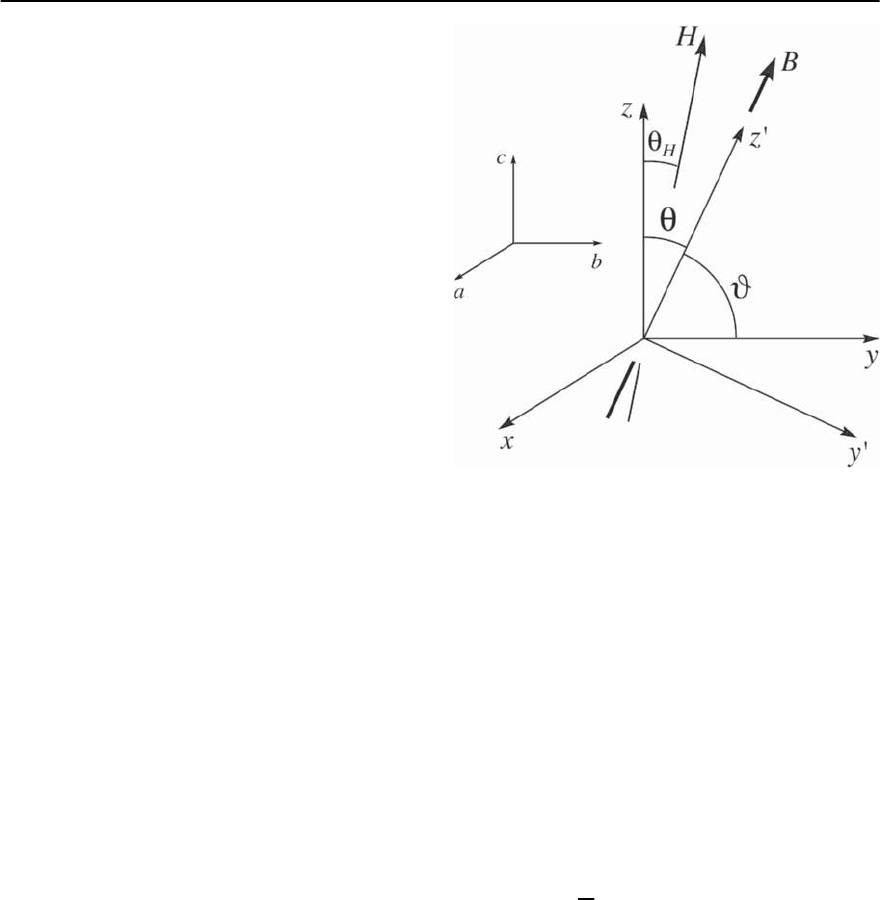Bennemann K.H., Ketterson J.B. Superconductivity: Volume 1: Conventional and Unconventional Superconductors; Volume 2: Novel Superconductors
Подождите немного. Документ загружается.


500 G. Blatter and V.B. Geshkenbein
" < 1/50 in BiSCCO (depending on oxygen dop-
ing the anisotropy may be much larger with " of
order 10
−3
[25]). The anisotropy strongly promotes
thermal and quantum fluctuations, since Gi ∝ 1/"
2
and Qu ∝ 1/". The above material parameters tend
to increase the importance of the fluctuations in
the high-temperature superconductors.Whereas the
mean-field description was quite sufficient for the
understanding of the conventional low-temperature
superconductors this isno longerthe case for thenew
materials.In particular,the increase of Gi by roughly
six orders of magnitude implies that the vortex lat-
tice is melted over a large portion of the H–T phase
diagram; similarly, the increase of Qu by two orders
of magnitude renders macroscopic quantum effects
relevant. We wish to point out that these novel ef-
fects are not unique to high-temperature supercon-
ductors, they are present as well in the conventional
low-T
c
materials. However, it is the special set of ma-
terial parameters in the oxides which renders these
phenomena physically important and accessible to
experimental investigations.
The special material properties of the high-
temperature superconductors not only push the im-
portance of fluctuations, they also tend to decrease
pinning in these materials. The weak pinning (small
j
c
/j
0
) is not only a consequence of the small coher-
ence length , but also follows from the absence
of generic extended pinning sites in these materi-
alssuchasprecipitatesorgrainboundariesoccur-
ring in many conventional superconductors. Again,
this circumstance is a consequence of the oxides be-
ing doped insulators rather than conventional met-
als, hence pinning centers are mainly provided by
point-defects, e.g., oxygen vacancies [26]. An im-
portant exception are the twin boundaries in YBCO
which provide extended pinning sites [27,28] upon
proper alignment of the magnetic field. Further-
more, in order to boost the critical current density
for technological applications strong pinning cen-
terscan beintroducedartificiallythroughirradiation
of the material with heavy ions producing columnar
tracks [29,30].
The generic weakness of pinning in the high-
temperature superconductors is interesting from a
theoretical point of view as it allows to treat the ef-
fects of quenched disorder perturbatively. In partic-
ular, weak pinning implies the existence of a well
definedstartingHamiltonianintheformofacon-
tinuumelastic description of the vortex lattice, upon
which effects due to disorder can be studied in a well
defined fashion. The dynamical behavior of the vor-
tex system in the presence of quenched disorder then
can be studied within the framework of the weak
collective pinning theory introduced by Larkin and
Ovchinnikov [8,10]. Furthermore, if pinning is weak
enough,the melting transition separating the vortex-
solid and liquid phases will be only little perturbed
by the presence of quenched disorder, allowing for
the observation of a generic melting transitionin the
vortex system.
The above discussion shows that we can expect
a wealth of novel phenomena in type II supercon-
ductors;atthesametimetheseshouldbeexperi-
mentally accessible and theoretically tractable in a
well defined fashion, thus allowing for a mutual ex-
change of experimental and theoretical results. On
the experimental side such novel phenomena include
the broadening of the resistive transition in a finite
magnetic field [31–33], the existence of a distinct ir-
reversibility line far below H
c
2
[34], often associated
with a vortex-glass transition [35],the appearance of
a first-order vortex lattice melting transition in high
quality crystals [36–43], the presence of giant creep
[44–46] even at temperatures far below T
c
[47,48],
a rapid decrease in the critical current density j
c
with increasing temperature [49], and the appear-
ance of quantum effects on approaching zero tem-
perature [50–52]. On the theoretical side the statis-
tical mechanics and the dynamics of individual vor-
tices and of the vortex lattice has been studied in ho-
mogeneous and in disordered environments. These
investigations have led to the postulation of new
phase transitions in the vortex system, such as the
vortex-lattice melting [11–13] andvortex-glass tran-
sitions [15,16].New vortexphases such as the entan-
gled and the disentangled vortex-liquids [11,53,54],
the vortex-glass [15–17], the Bragg-glass [19–21],
and the Bose-glass phase [55] have been proposed.
The presence of thermal fluctuations leads to ther-
mal depinning of vortices [23]. The dynamical re-
sponse of the vortices is very different in these var-

12 Vortex Matter 501
ious phases and thus can be used for the charac-
terization of the new vortex-liquid [56] and vortex-
glass phases [15–17,19–21]. Also, the study of classi-
cal vortex motion has been extended to the quantum
regime [24,57].
A second source of novel phenomena is associ-
ated with the layered structure of the new oxides.
Whereas the YBCO compound still can be described
reasonably well within a continuum anisotropic
model, the layered Bi- and Tl-based compounds have
to be described by a discrete Lawrence–Doniach
model [58]. Superconductivity in these materials
then assumes features of quasi-two-dimensionality
and many experiments exhibit a characteristic Be-
rezinskii–Kosterlitz–Thouless (BKT) type behavior
[59,60].Dependingonthephysical situation,thesim-
ple rectilinear vortex has to be replaced by a more
complex object consisting of an array of 2D-pancake
vortices interconnected by (coreless) Josephson vor-
tices running parallel in between neighboring su-
perconducting planes [61–65]. The layered struc-
ture also introduces new features in the dynamical
response of the vortices due to the appearance of
intrinsic pinning and creep [66–69]. The statistical
mechanics of the vortex system is affected by the
layering via the presence of large (quasi-2D) fluc-
tuations [70] and also through the appearance of
new phase transitions, e.g., a layer decoupling tran-
sition in a field H directed perpendicular to the lay-
ers [64,71–76]. When the field H is directed parallel
to the layers commensuration effects appear between
the crystal and the magnetic structure [77–80]; the
prediction of a decoupling transition in this geome-
try and an associated smectic transition [62,79–84]
is much disputed [85–88].
Much interest has concentrated on attempts to in-
crease the criticalcurrentdensity via the artificialin-
troduction of strong pinning centers (e.g., columnar
defects [29,30,89–91]) and the investigation of the
macroscopic properties of the new materials [92–95].
While research on these topics is driven by their
relevance for technological applications of high-
temperature superconductors,it is exciting to notice
that they bear a wealth of fundamental questions,
such as the substitution of the vortex-glass phase by
the Bose-glass phase in the case where the disorder
is correlated [55], or the relation of the macroscopic
behavior of a type II superconductor in a magnetic
field with ideas of self-organized criticality [96,97].
In order to give a theoretical description of these
very diverse phenomena one has to gather various
concepts and results from different branches ofmod-
ern theoretical physics, such as the theory of elas-
tic manifolds in quenched random media, polymer
physics, spin-glass theory, fluctuational theory of
phase transitions, strongly correlated quantum sys-
tems,disordered quantumBose liquids,macroscopic
quantum tunneling, hopping conductivity in semi-
conductors, and self-organized criticality. The above
discussion then illustrates the richness and complex-
ity we encounter when dealing with the physics of
Vortex Matter.
The main philosophy followed below is to base all
the discussions on some “basic Hamiltonian” with
the requirement that it shall describe the vortex sys-
tem accurately. In particular, all the internal struc-
ture existing in the vortex system (e.g., the vortex
lattice) as well as the interactions present in the sys-
tem (e.g., between the vortices and the static dis-
order potential) shall be accurately described by
the model Hamiltonian. Examples for such “micro-
scopic Hamiltonians” used below are the (continu-
ous anisotropic) Ginzburg–Landau and London free
energy functionals, the discrete Lawrence–Doniach
model, and the continuum elastic free energy func-
tional for the vortex lattice. We emphasize that the
theory of Vortex Matter developed below applies
equally well to conventional low-T
c
and to uncon-
ventionalcopper-oxidehigh-T
c
superconductors,the
only requirement being that the order parameter de-
scribing the superfluid is a scalar quantity; given the
d
x
2
−y
2
-symmetry of the order parameter [98–100]
this condition is satisfied. In our terminology we
use the term “microscopic” when referring to length
scales ≥ , with the coherence length denoting the
smallest scale in our problem. The calculation of
itself is the subject of truly microscopic considera-
tions involving the solution of a very complicated
many-body problem; here, we will treat as a phe-
nomenological parameter. Also, we will require our
starting Hamiltonians to describe a minimal model.
In particular, we will introduce the simplest possi-

502 G. Blatter and V.B. Geshkenbein
ble type of disorder in the system, usually described
by short-ranged Gaussian correlations. It turns out
that the physics described by such a minimal model
is already quite rich and accounts for a wealth of
experimental observations in a consistent manner.
Of course, starting out with these still very complex
Hamiltonians we cannot hope to develop exact an-
swers to our questions. We thus will have to resort to
approximate methods in dealing with the vortex sys-
tem, such as scaling estimates or perturbative anal-
ysis. The vortex system subject to quenched disor-
der, thermal and quantum fluctuations, and possibly
driven by external forces is a complex object, and the
structure of the answers we will derive below is not
simple but involves many regimes where the behav-
ior of the system is different.
In what follows, we first discuss the basic frame-
work for the discussion of Vortex Matter, the
Ginzburg–Landau, London, Lawrence–Doniach and
continuum elastic theories.We discuss single vortex
properties in Sect.12.3,the vortexlattice in Sect.12.4,
pancake and Josephson vorticesin layered supercon-
ductors in Sect. 12.5, and the general scaling theory
used in the description of anisotropic material in
Sect. 12.6. Turning to the statistical physics of vor-
tex systems (Sect. 12.7) we discuss the various fluc-
tuation regimes, the vortex lattice melting and de-
coupling transitions, and the nature of the resulting
vortex liquid phase.Wethen concentrate on the prop-
erties of vortex matter in the presence of quenched
disorder,startingwithanoverview(Sect.12.8) ondif-
ferent types of pinning, e.g. strong versus weak pin-
ning, pinning by uncorrelated/correlated disorder,
and a general discussion of vortex creep.In Sect.12.9
we present a detailed discussion of the theory of
weak collective pinning and creep: we analyze single-
vortex pinning and creep,its generalization to vortex
bundles, the phenomenon of quantum creep at low
temperatures and thermal depinning at high temper-
atures.Aspects of anisotropy andof the layered struc-
ture are dealt with as well.We proceed (in Sect.12.10)
with a discussion of strong pinning due to corre-
lated disorder (e.g.,due to columnar tracks) and then
concentrate on the effects of surface and geometri-
cal barriers (Sect. 12.11).Turning back to thermody-
namic aspects, but now in the presence of disorder,
we discuss the vortex-glass phases (see Sect. 12.12)
and the possibility ofa field-driven disorder-induced
melting transition at low temperatures.We close with
a discussion of Vortex Matter phase-diagrams. Un-
fortunately, this program leaves out a number of
prominent topics: among them are the c-axis trans-
port [101] and Josephson plasma physics [102,103]
in layered superconductors, the physics of moving
vortex systems [104], or the structure of individual
vortex lines in d-wave superconductors[105–107].
An introduction to the phenomenology of type II
superconductors can be found in [96,108,109]; sev-
eral aspects of Vortex Matter physics have been dis-
cussed in recent reviews [38,110] and the statistical
physics of dirty elastic manifolds has been reviewed
in [111,112].
12.2 Ginzburg–Landau and London Theories
The phenomenological description of supercon-
ductivity is based on the Ginzburg–Landau (GL)
free energy functional [15]: The quantum liquid
is described by a complex order parameter field
¦ (r)=|¦ (r)| exp[i'(r)].Furthermore,ifthefluidis
charged, as is the case in superconductors, the order
parameter field ¦ (r) couples to the vector-potential
field A(r) in a gauge invariant way. The free energy
functionals describing the superconductor take the
form
G[¦ , H]=F[¦ , B]−
d
3
r
H · B
4
,
F[¦ , B]=
d
3
r
˛|¦ |
2
+
ˇ
2
|¦ |
4
(12.1)
+
3
=1
1
2m
i
d
dx
+
2e
c
A
¦
2
+
B
2
8
and have to be completed by the Maxwell equations.
The magnetic field B = ∇∧A is driven by the ap-
plied external field H. The Ginzburg–Landau (GL)
parameter ˛ =−|˛(0)|(1−T/T
c
)changessignatthe
transition temperature T
c
while ˇ assumes a con-
stant value. We choose the charge unit e to be posi-
tive, e > 0. The parameters m
, =1, 2, 3, denote
the effective masses along the main axes of the crys-
tal. Here, we are mainly interested in isotropic and

12 Vortex Matter 503
in uniaxially anisotropic material described by effec-
tive masses m
x
= m
y
= m and m
z
= M and a mass
anisotropy ratio
"
2
= m/M < 1 ; (12.2)
while the isotropic case (m
= m, =1, 2, 3)
mainly serves to introduce the basic ideas and con-
cepts,many of theinteresting strongly fluctuating su-
perconductors, such as the copper-oxide or organic
materials [113], are layered crystals and hence uni-
axially anisotropic.
We choose a coordinate system with the z-axis
parallel to the axis of the material (the c-axis) and the
x and y-axes in the isotropic ab-plane, see Fig. 12.4.
An additional parameter appearing in the discussion
of anisotropic superconductors is the direction ofthe
external magnetic field H with respect to the crystal
axes: the external field H is chosen to lie in the yz-
plane and to enclose an angle
H
with the c-axis (an
angle #
H
= /2−
H
with the ab-plane,see Fig. 12.4;
below we consistently use and # = /2− to de-
note angles measured from the c-axis and from the
ab-planes). In the following, we will deal with the
isotropic case first and discuss the generalization to
the anisotropic situation whenever appropriate.
The Ginzburg–Landau energy (12.1) describes a
one-component superfluid and applies to conven-
tional (isotropic) s-wave superconductors.More gen-
erally, the functional (12.1) with a scalar order pa-
rameter field ¦ (r) also describes unconventional su-
perconductors with order parameters belonging to
other symmetry classes, with the constraint that the
symmetry representation is one-dimensional. E.g.,
in the high-T
c
superconductors the l =2angu-
lar momentum channel splits under the tetrago-
nal/orthorhombic crystal symmetry and the rele-
vant irreducible representation (of d
x
2
−y
2
symmetry)
is one-dimensional. The phenomenological descrip-
tion of Vortex Matter in type II superconductors de-
veloped below thus equally describes the situation in
conventional low-T
c
and in unconventional high-T
c
(copper-oxide) materials. In particular, the paramet-
ric dependence of the phenomenological parameters
entering the Ginzburg–Landau functional (12.1) on
the underlying microscopic parameters remain the
same, while numericals may be different. Examples
Fig. 12.4. Coordinate systems used in the description of
anisotropic and layered superconductors. The axes x, y,
and z are aligned with the crystal axes a, b,andc; c is the
axis of uniaxial anisotropy and the ab-plane contains the
superconducting layers.The magnetic field H liesin theyz-
plane and encloses an angle
H
= /2−#
H
with the c-axis.
The induction B is in general not aligned with the mag-
netic field H and encloses an angle # with the ab-plane.
The coordinate system x
, y
, z
is aligned with the induc-
tion B and has a common x axis with the crystal system,
x
= x
where the d-wave symmetry of the high-T
c
’s leads to
strong (parametric) modifications of phenomeno-
logical results are rare; they appear in the context
of low-energy quasi-particle excitations in the gap
nodes, e.g., in connection with the field-dependence
of the low-temperature specific heat [114,115] scal-
ing like c
v
∝
√
H instead of the conventional behav-
ior c
v
∝ H, the low-temperature dependence of the
superfluid density n
s
(0) − n
s
(T) ∝ T [116], or the
non-linear Meissner effect (H)−(0) ∝ H [117],
which appears difficult to confirm experimentally,
though [118,119].
The homogeneous solutions of (12.1) are ¦
0
=0
(normal state) and |¦
0
|
2
= |˛|/ˇ (superconduct-
ing state). The energy gain in the superconducting
state (˛ < 0) is due to the condensation energy

504 G. Blatter and V.B. Geshkenbein
H
2
c
/8 = ˛
2
/2ˇ,withH
c
the thermodynamic critical
field.In the inhomogeneous situation the variation of
(12.1) with respect to the fields ¦
∗
and A furnishes
the equations determining the spatial variations of
the order parameter ¦ = |¦ |exp(i') and the vector
potential A (we concentrate on the isotropic situation
here),
2
∇ +
2i
¥
0
A
2
¦ +
1−
|¦ |
2
|¦
0
|
2
¦ =0, (12.3a)
2
|¦
0
|
2
|¦ |
2
∇∧(∇∧A)+A =−
¥
0
2
∇' , (12.3b)
where ¥
0
= hc /2e ≈ 2.068 10
−7
Gcm
2
denotes the
flux unit. Equation (12.3b) is conveniently rewritten
with the help of Amp`ere’s equation ∇∧B =(4/c)j
andprovidesuswithanexpressionforthecurrent
density
j =−
e
mi
[¦
∗
∇¦ − ¦ ∇¦
∗
]−
4e
2
mc
¦
∗
¦ A , (12.4)
=−
2e
m
|¦ |
2
∇' +
2
¥
0
A
≡ −
2e
m
|¦ |
2
∇˜' ,
where we have defined the gauge-invariant phase
gradient ∇˜'. The characteristic lengths entering the
GL equations are the coherence length (T) and the
penetration depth (T),
2
(T)=
2
2m|˛(T)|
=
2
0
1
1−T/T
c
, (12.5a)
2
(T)=
mc
2
16e
2
|¦
0
(T)|
2
=
2
0
1
1−T/T
c
, (12.5b)
determining, respectively, the scale of variations in
the order parameter ¦ and in the potential A (or
magnetic inductionB,current density j =(c/4)∇∧
B). In the following, we use the zero temperature val-
ues of the length scales and for the character-
ization of the superconductor. The thermodynamic
critical field H
c
is conveniently expressed through
these two basic scales,
H
c
=
¥
0
2
√
2
. (12.6)
The maximal dissipation free current density the su-
perconductor can carry (the depairing current den-
sity) takes the value
j
0
=
cH
c
3
√
6
; (12.7)
for larger current densities the kinetic energy of
Cooper pairs is larger than the energy gap and
the pairs unbind.
The Ginzburg–Landau theory derives from an ex-
pansion in the small order parameter ¦ and hence
its applicability is restricted to temperatures close to
the superconducting transition temperature T
c
.Al-
ternatively, we can ignore spatial variations in the
order parameter and construct a free energy from
the kinetic energy of the currents j =(c/4)∇∧B
and the magnetic field energy B
2
/8.Theresulting
London free energy functional takes the form
F
L
[B]=
1
8
d
3
r
B
2
+
2
(∇∧B)
2
(12.8)
and is valid within the whole temperature range
0 < T < T
c
as long as the magnetic field does not
leadto a significant suppression of the order parame-
ter. For the strong type II superconductorswith large
Ginzburg–Landau parameter = / 1weare
(mainly) interested in here, the London theory 12.8
provides a good approximation to the phenomeno-
logical description of superconductivity over a large
portion of the H-T phase diagram. The penetration
depth appearing in (12.8) relates to the density n
s
of superconducting electrons via
2
(T)=
mc
2
4n
s
(T)e
2
(12.9)
and the supercurrent density j canbewritteninthe
alternative forms
j =−
c
4
2
¥
0
2
∇' + A
=−en
s
v
s
,
v
s
=
2m
∇' +
2
¥
0
A
, (12.10)
with v
s
denoting the superfluid velocity (in general,
the total current density j can pick up an additional
normal component j
n
, in which case we will denote
the supercurrent density (12.10) by j
s
). Variation of
(12.8) with respect to B provides us with the London
equation

12 Vortex Matter 505
[1 −
2
∇
2
]B =0. (12.11)
Note that we distinguish between the extrapolated
zero-temperature parameter
0
of the Ginzburg–
Landau theory, cf. (12.5b), and the zero-temperature
BCS expression [120] for this length,
(0) ≈ 1.41
0
. (12.12)
A similar relation holds for the coherence length,
(0) ≈ 1.36
0
.Belowwewillmakeuseofthein-
terpolation formula (T)
2
≈ (0)
2
/(1 − T
2
/T
2
c
);
also, in going from a Ginzburg–Landau to a Lon-
don description we will use the definition |¦
0
|
2
=
(n
s
(0)/4)(1 − T
2
/T
2
c
)withtheT =0superfluidden-
sity equal to the electronic density n, n
s
(0) = n.The
above results apply to a clean material with a mean
free path l > (0); for a dirty material (l < (0)) we
have to replace
2
→ ()
2
and
2
→
2
/()
with ≈ 1.17/, = v
F
/2T
c
l;goingoverto
a dirty material increases the GL parameter and
the superconductor becomes more strongly type II.
In unconventional superconductors described by a
scalar order parameter the GL parameters involve
additional angular averages over products involving
the structure of the gap function (k)(ofd
x
2
−y
2
sym-
metry in the copper-oxide high-T
c
superconductors)
and the Fermi velocity v
F
(k); these angular averages
depend on the details of the Fermi surface and gap
shapes and can modify the numerical factors relat-
ing the GL parameters,and hence also and ,tothe
underlying microscopic parameters [121,122].
In an anisotropic material the London free energy
and the London equations take the form (in the vor-
tex frame of reference (x
, y
, z
), cf. Fig. 12.4)
F
L
[B]=
1
8
d
3
r
(12.13)
×
B
2
+(∇
∧ B) · · (∇
∧ B)
and
[B + ∇
∧ [ · (∇
∧ B)] = 0 ; (12.14)
here,
˛ˇ
=
2
ı
˛ˇ
+(
2
c
−
2
)n
˛
n
ˇ
denotes the screen-
ing tensor with and
c
= /" the in-plane and
out-of-plane screening lengths and n
˛
are the com-
ponents of the unit vector pointing along the crystal
axis (as seen from the vortex frame of reference; for
asystemwithB ˆz we have
11
=
22
=
2
= "
2
33
and 0 else).
12.3 Vortex Lines
The Ginzburg–Landau equations (12.3a)–(12.3b)
admit topological solutions, these flux lines, or
Abrikosov vortex solutions determine the rich phe-
nomenological phase diagram of type II supercon-
ductors with = / > 1/
√
2. The cylindrical
vortex- or flux-lines exhibit a non-trivial structure
in the order parameter field ¦ and in the magnetic
field B: the phase of the order parameter turns by
2 and drives a rotating current (note that with
the present definition of the charge (e > 0) the
phase field generating a vortex line rotates clock-
wise, ∇'
v
=−ˆz ∧ R/R
2
). Near the center of the
phase-turn the currents become large and suppress
the order parameter to zero, leading to a vortex
core of size . At the same time, the rotating cur-
rents generate a magnetic field and thus bind a
flux to the vortex extending a distance away from
the vortex core, where it saturates to the flux unit
¥
0
= hc /2e ≈ 2.068 10
−7
Gcm
2
.
To be more quantitative (see [96,108, 109] for a
standard derivation), let us integrate the cylindri-
cal current flow (12.5), generated by a wave function
¦
v
= |¦
v
|exp(−in ' )withn phase turns, along a loop
R
of radius R,
R
dl · j =2Rj
'
(R)=
2e
m
|¦
v
|
2
2
n −
¥ (R)
¥
0
.
(12.15)
Here,¥ (R)=
R
dl·A is the fluxpenetrating the loop.
The vortex solution (n = 1) then involves a circular
current flow j
'
(R)=(2e|¦
v
|
2
/mR)[1 − ¥ (R)/¥
0
].
The apparent divergence of this current density upon
approaching the origin is cutoffthrough thesuppres-
sion of the order parameter ¦
v
on the scale R ∼
as the current density j
'
becomes of the order of
the depairing current density j
0
; a convenient expres-
sion for this suppression as obtained via a variational
Ansatz [123,124] has the form
|¦
v
|
2
(R) ≈
R
2
R
2
+2
2
|¦
0
|
2
. (12.16)
Going to large distances, the screening currents as-
semble a flux ¥ (R)oftheorderofthefluxunit¥
0
on a scale R ∼ ; increasing R beyond the drive

506 G. Blatter and V.B. Geshkenbein
∝ [1 − ¥ (R)/¥
0
] vanishes and the current density
j
'
drops to zero rapidly: this is the phenomenon of
transverse screening.
The precise shape of the trapped magnetic field
B(R) follows from the London equation (12.11) com-
pleted with a source term ¥
0
ˆz ı
2
(R) describinga vor-
tex line placed at the origin,
[1 −
2
∇
2
]B = ¥
0
ˆz ı
2
(R) ; (12.17)
integration provides us with the magnetic field (for
R > )
B(R)=
¥
0
ˆz
2
2
K
0
R/
(12.18)
(K
0
()istheMacDonaldfunction,K
0
( 1) ∼
−ln; K
0
( 1) ∼ e
−
/
√
). The kinetic energy
of the screening currents j
'
gives rise to the line en-
ergy
l
of the vortex,
l
=
d
2
R
2
2m
∇ +
2i
¥
0
A
¦
v
2
≈
2
|¦
0
|
2
m
dR
R
=
¥
0
4
2
ln
. (12.19)
The prefactor
"
0
=
¥
0
4
2
(12.20)
defines the basic energy scale of Vortex Matter. The
above estimate for the line energy involves only the
kinetic energy of the currents and has to be com-
pleted by the magnetic field- and normal-core con-
densation energies; the magnetic energy contributes
aterm"
0
/2 and a similar term C"
0
with C anumer-
ical small compared to the logarithm ln(/ )hasto
be added for the core.The numerical solution of the
Ginzburg–Landau equation (with 1) provides
the result [125]
l
=
¥
0
4
2
ln
+0.497
(12.21)
(note that the constant in (12.21) differs from usual
values cited in the literature [96,108,109]).Inuncon-
ventional d-wave superconductors the currents and
magnetic fields appearing in the vortex core can in-
duce other order parameter components,e.g. of the s
or d
xy
-type[105],however,their impact on thevortex
shape is usually small.
These topological solutions of the Ginzburg–
Landau equations are crucial in determining the
(mean-field) H–T phase diagram of a type-II super-
conductor: At small magnetic fields the supercon-
ductor is strong enough to expel the magnetic field
and this defines the Meissner–Ochsenfeld state. In-
creasing the field, the free energy of the vortex state
drops below that of the Meissner state when the vor-
tex line energy
l
matchesupwiththemagneticen-
ergy ¥
0
H/4 and we find the lower critical field H
c
1
(see Fig. 12.1),
H
c
1
=
4
l
¥
0
=
¥
0
4
2
ln
+0.497
. (12.22)
Going beyond H
c
1
, vortices rush into the supercon-
ductor to form a triangular lattice (named after
Abrikosov [3]) with the lattice constant a
and the
density n
0
= a
−2
0
determined by the induction B,
a
=
2
√
3
1/2
¥
0
B
1/2
and a
2
0
=
¥
0
B
. (12.23)
In a large external field H the vortex cores start over-
lapping when a
0
≈ and superconductivity disap-
pears above the upper critical field H
c
2
,
H
c
2
=
¥
0
2
2
, (12.24)
giving way to the normal-metallic phase.
In an anisotropic material the line energy depends
on the angle # between the vortex and the ab-plane
of the material [126,127], see Fig. 12.4,
l
(# )="
0
"
#
ln
"
#
, (12.25)
with the angle-dependent anisotropy parameter
"
2
#
= "
2
cos
2
# +sin
2
# (12.26)
and "
0
=(¥
0
/4)
2
, denoting the in-plane screen-
ing length. The lower critical field H
c
1
is obtained
by minimizing the Gibbs free energy G;atsmall
values of B we have G ≈ B
2
/8 +(B/¥
0
)
l
(# )−
(BH/4)cos(# − #
H
), where # (#
H
) denotes the an-
gle enclosed by B (H)andtheab-plane. Minimizing

12 Vortex Matter 507
G with respect to B
y
and B
z
and setting B to zero we
find the lower critical field [126]
H
c
1
(
H
) ≈
¥
0
4
2
"
"
H
ln
"
#
= H
c
c
1
"
"
H
ln(/"
#
)
ln()
, (12.27)
where
H
denotes the angle enclosed between the
magnetic field H and the c-axis, hence "
2
H
=
cos
2
#
H
+ "
2
sin
2
#
H
.Theangle# at H
c
1
is given
by tan
2
# = "
2
tan
2
#
H
and we can reexpress "
#
=
"
2
(1 + "
2
tan
2
#
H
)/(1 + "
4
tan
2
#
H
) in (12.27). Min-
imizing G with respect to # we obtain the relation
between #
H
and # away from H
c
1
(note that # < #
H
and the vortex lines tend to align with the supercon-
ducting planes),
sin(#
H
− # )=
H
c
c
1
H
(1 − "
2
)sin# cos#
"
#
ln(/"
#
)
ln()
.
(12.28)
The expression for the upper critical field follows
from the anisotropic vortex core with dimensions
and "
#
H
along x and y
and takes the form
H
c
2
(#
H
)=
¥
0
2"
#
H
2
= H
c
c
2
1
"
#
H
. (12.29)
For large fields we have to replace the log-
arithm ln(/"
#
) in (12.28) by its counterpart
ln[˛H
c
2
(# )/B)
1/2
] (cf. (12.54) below); for H
H
c
c
1
/"
#
the misalignment between the magnetic field
H and the induction B becomes small.
12.3.1 Elasticity
Within a phenomenological or statistical mechanics
description a vortex is usually modeled as an elastic
string which, when compared with a point-like ob-
ject, exhibits additional static and dynamic proper-
ties due to its one-dimensional extended nature. The
elastic response of the vortex line is determined by
its line tension: We consider a vortex in an isotropic
material aligned with the z-axis of our coordinate
system. The elastic energy of a deformed vortex is
determined by the increase of the vortex length,
F
el
=
dz
l
=
[1 + (@
z
u)
2
]
1/2
−1
>
,
≈
dz
"
l
2
@u
@z
2
, (12.30)
where u(z)=(u
x
, u
y
) denotes the displacement field
of the vortex. In an isotropic material the long wave-
length line tension "
l
is equal to the line energy
l
,
"
l
= "
0
ln
+0.497
. (12.31)
In general, however, the vortex line tension is dis-
persive; solving the London equation for a deformed
vortex s(z)=[u(z), z ],
[1 −
2
∇
2
]B = ¥
0
dz
ds
dz
ı
3
(r − s(z)) (12.32)
(conveniently done in Fourier space) and inserting
the result back into the London functional (12.8)
rewritten in the form F
L
=(1/8)
d
3
rB(r)[1 −
2
∇
2
]B(r) we obtain the energy of the distorted vor-
tex line
F
L
[s(z)] =
"
0
2
dzdz
du(z)
dz
, 1
(12.33)
×
du(z
)
dz
, 1
V[s(z)−s(z
)] ,
with the interaction potential between vortex seg-
ments
V(r)=4
2
d
3
k
(2)
3
e
ikr
V(k) ,
V(k)=
e
−
2
k
2
1+
2
k
2
. (12.34)
Expanding (12.34) to second order in the distortion
u(z) one arrives at the dispersive line tension [173],
"
l
(k
z
) ≈ "
0
ln
2
1+
2
k
2
z
1/2
(12.35)
+ "
0
1
2
k
2
z
ln(1 +
2
k
2
z
)
1/2
.
This expression is usually dominatedby the first term
with its weak logarithmic dispersion,"
l
(k
z
> 1/) ≈
"
0
ln(1/k
z
). The result (12.36) is easily understood
in the following terms: the line energy (12.19) of a
vortex mainly arises from the currents circulating

508 G. Blatter and V.B. Geshkenbein
the core, which usually are cut off at short (the core
radius ∼ ) and long (the screening length ∼ )
distances. In a short wavelength distortion only cur-
rents on scales smaller than 1/k
z
are distorted and we
have to replace the cutoff by 1/k
z
.Similarly,the sec-
ond term originates from distortions in the magnetic
field: a short wavelength distortion (k
z
> 1/)in-
volves only a fraction 1/k
2
z
2
of the total field energy
"
0
/2 and we obtain the strongly dispersive electro-
magnetic component of the line tension. In (12.19)
wehaveignored afurther term accounting for thede-
formation of the vortex core which is dispersive on
the scale .Below we will deal with various phenom-
ena involving short wavelength distortions k
z
∼ 1/L
of the vortex line with < L (e.g., thermal
fluctuations with L ∼ a
0
at high fields or vortex
pinning). In this case we will often drop the logarith-
mic correction ln(1/k
z
) in the line tension and use
the approximation "
l
(k
z
∼ 1/L) ≈ "
0
.
In an anisotropic material the angular depen-
dence of the vortex line energy produces two dif-
ferent angle-dependent elasticities "
l
(# )and"
⊥
l
(# )
for in- and out-of-plane distortions: we start with
the energy
l
(L, # )=L
l
(# ) of a vortex segment of
length L enclosing an angle # with the ab-plane (see
(12.25)) and determine the increase in energy due to
a symmetric distortion Lı on a distance 2L;
ı
l
=
@
l
@L
ıL +
@
l
@#
ı# +
1
2
@
2
l
@#
2
(ı#)
2
. (12.36)
An out-of-plane tilt by an angle ı = ı# increases
the length of the segment by ıL ≈ L(ı#)
2
/2; simi-
larly,an in-plane distortion gives rise to an additional
length ıL ≈ L(ı)
2
/2 and produces a change in #
determined by tan(# + ı#)=L sin # /[(L cos # )
2
+
(Lı)
2
]
1/2
,henceı# =−(tan# )(ı)
2
/2. The out-
of-plane and in-plane elasticities are defined by the
relations
"
⊥
l
L(ı#)
2
2
=
@
l
@L
ıL +
1
2
@
2
l
@#
2
(ı#)
2
,
"
l
L(ı)
2
2
=
@
l
@L
ıL +
@
l
@#
ı#; (12.37)
a few algebraic manipulations then produce the ex-
pressions for the out-of-plane and in-plane elastici-
ties (we ignore logarithmic corrections)
"
⊥
l
≈
"
2
"
0
"
3
#
and "
l
≈
"
2
"
0
"
#
. (12.38)
A second contribution to the tilt modulus arising
from electromagnetic interactions is discussed in
Sect. 12.4.1.
12.3.2 Dynamics
A number of forces attack the vortex line (here par-
allel to ˆz) in a type-II superconductor in the dy-
namical situation andtheircorrectaddition(without
omissions or double counting) is far from trivial. We
distinguish between hydrodynamic forces arising at
large distances and forces due to quasi-particle scat-
tering in the vortex-core region;the most well known
example for a vortex equation of motion is given
through the compensation of the Lorentz force(from
hydrodynamics) and the Bardeen–Stephen friction
force (from dissipative scattering in the vortex core)
[5],
f
L
+ f
BS
=
¥
0
c
j ∧ˆz −
l
v
L
=0, (12.39)
resulting in a vortex velocity v
L
transverse to the
driving current density j; the viscousdrag coefficient
l
as derived by Bardeen and Stephen reads
l
=
¥
2
0
2c
2
n
2
, (12.40)
where
n
denotes the normal-state resistivity of the
material. In order to discuss the limitations of this
equation and the appearance of various other forces
attacking the individual vortex line, we consider a
simple phenomenological model providing us with
some insight into the origin of the vortex equa-
tion of motion; an accurate derivation starting from
microscopic theory has been given by Kopnin and
Kravtsov [128],see also [129,130].We model the vor-
tex core as a sharp normal cylinder with an elec-
tron density n
c
which in general may differ from the
asymptotic density n. The average force density act-
ing on the electronic system involves contributions
from the Lorentz force j ∧B/c, the electric field force
enE, and the scattering term mn
c
v
c
f (B/H
c
2
)/
r
(v
c
is
the carrier velocity in the vortex core and
r
is the
transport relaxation time),

12 Vortex Matter 509
j ∧ B/c + enE − mn
c
v
c
f (B/H
c
2
)/
r
=0. (12.41)
The normal metallic state is uniform and we have
n
c
= n, v
c
= v,andf =1;solvingtheequation
of motion (12.41) for the current density (velocity)
j = env we obtain the well known expressions for
the longitudinal and transverse (Hall) conductivi-
ties in the normal state,
=
n
/(1 + !
2
c
2
r
)and
⊥
=
n
!
c
r
/(1 + !
2
c
2
r
), with the normal state con-
ductivity
n
= e
2
n
r
/m and the cyclotron frequency
!
c
= eB/mc.
On the other hand, the superconducting state is
inhomogeneous and scattering is limited to the vor-
tex cores; correspondingly we introduce the reduc-
tion factor f ≈ B/H
c
2
. Furthermore, the electric
field is now determined by the vortex velocity via
E = B ∧ v
L
/c. Usually, the carrier density inside the
core is assumed to be equal to the asymptotic elec-
tron density, n
c
= n, and we can write the transport
current density in the form j = en
c
v
c
= en
s
v
s
, i.e.,
the current density flows through the system in a ho-
mogeneous manner (n
s
and v
s
denote the superfluid
density and its velocity). The force equation (12.41)
then relates the carrier velocity v
c
in the core to the
vortex velocity v
L
,
v
c
= !
0
r
(v
c
− v
L
) ∧ˆz , (12.42)
with !
0
≈ eH
c
2
/mc (in a clean material, !
0
≈
2
/2m
2
≈
2
/"
F
corresponds to the level split-
ting of the quasi-particles trapped in the vortex core
[131]). Solving for the velocity v
c
we obtain
v
c
=
!
0
r
1+!
2
0
2
r
ˆz ∧ v
L
+
!
2
0
2
r
1+!
2
0
2
r
v
L
, (12.43)
and taking the cross product of (12.43) with
en(¥
0
/c)ˆz we obtain the forceequation [132]
¥
0
c
j ∧ˆz =
l
v
L
+ ˛
l
v
L
∧ˆz , (12.44)
with the response parameters
l
= n
!
0
r
1+!
2
0
2
r
and ˛
l
= n
!
2
0
2
r
1+!
2
0
2
r
,
(12.45)
consistent with the result derived from a micro-
scopic analysis [128]. The two terms in (12.44) then
push the vortex either in a direction transverse to
the driving current (dissipative motion governed
by
l
)ordragthevorticesalongthecurrentdi-
rection (Hall motion governed by ˛
l
). The result-
ing vortex motion produces longitudinal and trans-
verse (Hall) flux-flow conductivities of the form
FF
=(H
c
2
/B)
n
/(1 + !
2
0
2
r
)and
⊥FF
= !
0
r
FF
.
Usually,the parameter !
0
r
is small,!
0
r
1,i.e.,
themeanfreepathl isnot large,l "
F
/ ≈ (k
F
);
we then recover the dissipative equation of motion
(12.39). The vortex exhibits a fast (v
L
≈ v
s
/!
0
r
)
motion transverse to the flow j = en
s
v
s
.Theresult-
ing large electric field E ≈ v
L
H
c
2
/c in the core re-
gion provides the necessary drive to push the nor-
mal current density j
n
through the core such that
the overall current flow is divergence free [123],
∇·(j
n
+j
s
) = 0.The frictioncoefficient agrees withthe
expression derived by Bardeen and Stephen [5]; the
flux-flow conductivity is given by the well known ex-
pression
FF
=(H
c
2
/B)
n
(note that corrections to
the Bardeen–Stephen result become important near
the transition temperature and for high magnetic
fields [133,134]).
Expressions similar to (12.45) are obtained in the
quasi-classical analysis of flux flow in d-wave super-
conductors [135]; as expected the results keep their
parametric form but involve additional angular av-
erages of the gap structure over the Fermi surface, at
least for moderate disorder. Modificationsdue to the
gap nodes appear in very clean material only (the
so-called “superclean” limit with a large mean free
path l > "
F
/, see below); these are, an unusual
magnetic-field dependence of
FF
∝ B
−3/2
,univer-
sal limits (independent of
r
) of the flux-flow conduc-
tivities for low temperatures and fields, and a resid-
ual (in the limit
r
→∞) finite dissipation due to
Landau damping on zero-frequency vortex modes.
In an anisotropic material the viscous drag coef-
ficients depend on the direction # of the flux line
and on the direction of motion: the two effects of
an angle-dependent vortex core size "
#
2
and an
angle-dependent electronic mass m
e
/"
2
#
for the out-
of-plane (electronic) motion along y
compete with
each other and produce the dissipative response co-
efficients for the moving vortex in the form
l
= "
#
c
l
,
⊥
l
=
c
l
"
#
, (12.46)
